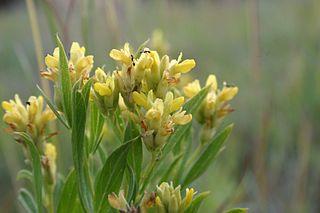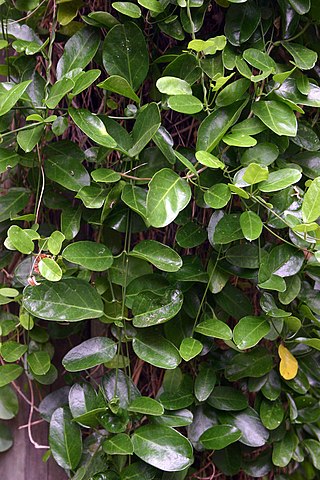
Tulbaghia is a genus of monocotyledonous herbaceous perennial bulbs native to Africa, belonging to the amaryllis family. It is one of only two known genera in the society garlic tribe within the onion subfamily. The genus was named for Ryk Tulbagh (1699–1771), one time governor of The Cape of Good Hope.

Osteospermum, is a genus of flowering plants belonging to the Calenduleae, one of the smaller tribes of the sunflower/daisy family Asteraceae. They are known as the daisybushes or African daisies. Its species have been given several common names, including African daisy, South African daisy, Cape daisy and blue-eyed daisy.

Psoralea is a genus in the legume family (Fabaceae) with 111 species of shrubs, trees, and herbs native to southern and eastern Africa, ranging from Kenya to South Africa. In South Africa they are commonly referred to as fountainbush (English); fonteinbos, bloukeur, or penwortel (Afrikaans); and umHlonishwa (Zulu).

Dovyalis is a genus of shrubs and small trees. Recent genetic evidence has shown the genus to belong to the family Salicaceae; formerly it was classified in the family Flacourtiaceae. The 15 species are native to Africa and southern Asia. Some are cultivated for their fruit.

Melolobium is a genus of flowering plants belonging to the legume family, Fabaceae. It includes 14 species of small shrubs or perennial herbs native to southern Africa, which are found in southern and eastern Namibia, southwestern Botswana, and most of South Africa.

Faurea is a genus containing 16 species of flowering plants in the protea family which occur in the summer rainfall area of southern Africa, extending to tropical Africa and Madagascar. The name honours South African soldier and botanist William Caldwell Faure (1822-1844) who was killed on active service in India.

Ruttya is a genus of plants in the family Acanthaceae. It includes six species native to eastern and southern Africa, Madagascar, and the southern Arabian Peninsula.

Pearsonia is a genus of 12 species of plants belonging to the family Fabaceae and occurring in Africa south of the equator with 1 species found on Madagascar. The species are usually herbs or shrublets with woody rootstocks. Leaves are usually sessile and 3-foliolate. The inflorescence is a congested or lax terminal raceme. The name of this genus commemorates the South African botanist Henry Harold Welch Pearson.
Callilepis is a genus of flowering plants in the family Asteraceae. It is native to southern Africa.

Thaminophyllum is a genus of South African plants in the chamomile tribe within the daisy family. It is endemic to the Cape Provinces.

Anisodontea is a genus of flowering plants in the tribe Malveae of the mallow family Malvaceae. It comprises 19 species native to South Africa and Lesotho. Members of the genus typically bear toothed leaves with three or five palmate, uneven lobes. Members of the genus also typically bear flowers with a pubescent calyx, a five-petaled corolla streaked from the center and pink to magenta in color, and stamens with anthers of a dark color.

Cynanchum ellipticum is a South African climbing plant of the family Apocynaceae. It has slender stems and branches, exuding milky, bitter latex that is non-irritant. It occurs in coastal scrub from Cape Town as far north as Mozambique and further inland up to 1300 m, and may be found on flats or moderate slopes, in sand or between rocks, in indigenous forests and along forest margins and thickets, frequently occurring in disturbed habitats.

Stenostelma is a genus of plants in the family Apocynaceae, first described as a genus in 1894. It is native to southern Africa, ranging from Mozambique, Zambia, and Namibia to South Africa.

Crassula brevifolia is a succulent plant in the family Crassulaceae. It is native to the arid western edge of South Africa as well as southern Namibia.

Crassula subaphylla is a succulent plant belonging to the family Crassulaceae. It is widespread in the Karoo regions of South Africa and Namibia.

Crassula pellucida is a creeping, succulent ground-cover, or low-growing, spreading succulent shrub. It is native to eastern and southern Africa, ranging from Kenya and Angola to South Africa.

Senecio venosus is a species of flowering plant in the family Asteraceae. It is endemic to South Africa, Botswana, and Zimbabwe.

Mystropetalon is a genus of flowering plants belonging to the family Balanophoraceae. Its native range is South Africa.
Othonna purpurascens is a species of flowering plant in the family Asteraceae. It is endemic to South Africa.

















